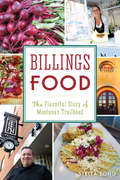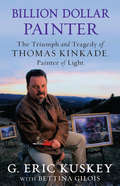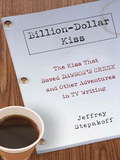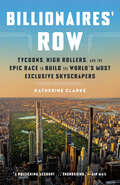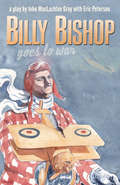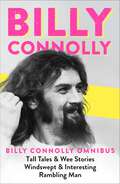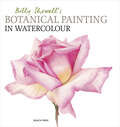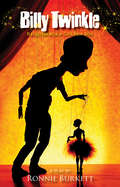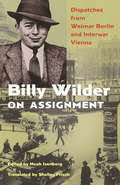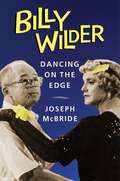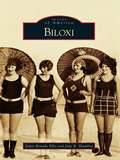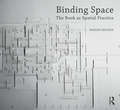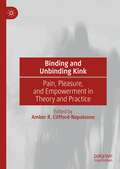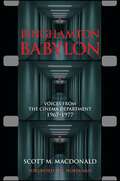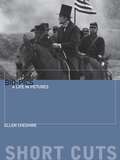- Table View
- List View
Billings Food: The Flavorful Story of Montana's Trailhead (American Palate)
by Stella FongBillings' local food scene is bootstrapping and standing tall. Renowned restaurants like TEN boast menus that showcase distinctive local ingredients from trout roe to foraged mushrooms. Restaurants and artisans source from centuries-old establishments like the McGowan family farm, which provides grain to Trailhead Spirits distillery. Mingling regional cuisine with the cosmopolitan influences of far-flung cities, homegrown spots like Lilac and Field House garner national attention with their daily dishes. Teppanyaki cooking and innovative global offerings are quickly diversifying the foodscape. Food journalist Stella Fong provides an eclectic sampling of the people, restaurants, producers and suppliers that contribute to the city's growing palate.
Billion Dollar Painter: The Triumph and Tragedy of Thomas Kinkade, Painter of Light
by Bettina Gilois G. Eric KuskeyThe unbelievable true story of artist Thomas Kinkade, self-described "Painter of Light,” and the dramatic rise -and fall-of his billion-dollar gallery and licensing business. He was just one man, but Thomas Kinkade ultimately made more money from his art than every other artist in the history of the world combined. His sentimental paintings of babbling brooks, rural churches surrounded by brilliant fall foliage, and idyllic countryside cottages were so popular in the 1990s that one out of every twenty homes in America owned one of his prints. With the help of two partners-a former vacuum-cleaner salesman and an ambitious junior accountant who fancied himself a businessman-Kinkade turned his art into a billion-dollar gallery and licensing business that traded on the NYSE before it collapsed in 2006 amid fraud accusations. One part a fascinating business story about the rise, and demise, of a financial empire born out of divine inspiration, one part a dramatic biography, Billion Dollar Painter is the account of three nobodies who made it big. One of them was a man who, despite being a devout Christian who believed his artwork was a spiritual force that could cure the sick and comfort the poor in spirit, could not save his art empire, or himself. Eric Kuskey, former colleague of Thomas Kinkade's and close friend until the artist’s death in 2012, tells Kinkade’s story for the first time-from his art’s humble beginnings on a sidewalk in Carmel, California, to his five-house compound in Monte Sereno. It’s a tale of addiction and grief, of losing control, and ultimately, of the price of our dreams.
Billion-Dollar Kiss
by Jeffrey StepakoffNow in paperback, the riveting behind-the-scenes look at how television shows are really created, from a successful writer-producerWhen Jeffrey Stepakoff was graduating with an MFA in playwriting, he imagined a life in theater. Writing for TV didn't even cross his mind. But he ended up in L. A. in the late eighties, when television writers were experiencing a gold rush. After the billion-dollar syndication of Seinfeld, the mania for scripted entertainment made the TV writer a hot commodity. Weaving his personal narrative with a history of television, Stepakoff shows what it's like to have a story idea one week and then have it seen by millions a week later. He also takes us inside the industry to explore the problems of media consolidation, interference by executives, lack of diversity, and what reality television is doing to quality scripted television.
Billionaires' Row: Tycoons, High Rollers, and the Epic Race to Build the World's Most Exclusive Skyscrapers
by Katherine ClarkeA fly-on-the-wall account of the ferocious ambition, greed, and financial one-upmanship behind the most expensive real estate in the world: the new Manhattan megatowers known as Billionaires&’ Row—from a staff reporter at The Wall Street Journal&“Deeply informative, delightfully entertaining, and addictively readable.&”—Diana B. Henriques, bestselling author of The Wizard of LiesTo look south and skyward from Central Park these days is to gaze upon a physical manifestation of tens of billions of dollars in global wealth: a series of soaring spires stretching from Park Avenue to Broadway. Known as Billionaires&’ Row, this set of slender high-rise residences has transformed the skyline of New York City, thanks to developer-friendly policies and a seemingly endless gush of cash from tech, finance, and foreign oligarchs. And chances are most of us will never be invited to step inside.In Billionaires&’ Row, Katherine Clarke reveals the captivating story of how, in just a few years, the ruthless real-estate impresarios behind these &“supertalls&” lining 57th Street turned what was once a run-down strip of Midtown into the most exclusive street on Earth, as legendary Trump-era veterans went toe-to-toe with hungry upstart developers in an ego-fueled &“race to the sky.&” Based on far-reaching access to real estate&’s power players, Clarke&’s account brings readers inside one of the world&’s most cutthroat industries, showing how a combination of ferocious ambition and relentless salesmanship has created a new market of $100 million apartments for the world&’s one-percenters—units to live in or, sometimes, just places to stash their cash.Filled with eye-popping stories that bring the new era of extreme wealth inequality into vivid relief, Billionaires&’ Row is a juicy, gimlet-eyed account of the genius, greed, and financial one-upmanship behind the most expensive real estate in the world—a stranger-than-fiction saga of broken partnerships, broken marriages, lawsuits, and, for a few, fleeting triumph.
Billy Bishop Goes to War
by John Gray Eric PetersonOne of Canada's most successful and enduring musical plays, Billy Bishop Goes to War was first published in 1982 and went on to win the Los Angeles Drama Critics' Award and the Governor General's Award for Drama. In 2010, the celebrated story of the World War I flying ace - credited with seventy-two victories and billed as the top pilot in the British Empire - was revised to frame the original play as a retrospective. It is the same play it always was - the difference is in the telling. Billy Bishop now appears in his later years, reflecting on his wartime exploits, and on the business of war and hero making. Bishop's reminiscence is not so much about the horror and death of war as it is about being young and intensely alive. "The prime of life / The best of men," Bishop sings, "It will never be / Like this again."A memory play about war, Billy Bishop has been going into battle onstage for more than thirty years. The Canadian classic is revisited in this second edition, where war is still a terrible thing, but some men say it was the greatest time of their lives. It's about the ironies and the price of survival.The play format is deceptively simple with a solo narrator who assumes multiple roles while his piano-playing sidekick offers sardonic musical comments.Cast of 2 men.
Billy Connolly Omnibus: Tall Tales and Wee Stories/Windswept & Interesting/Rambling Man
by Billy ConnollyTHREE TIMES THE LAUGHS: THE BEST OF BILLY CONNOLLY! 'Our greatest living comedian' Daily Mail'One of stand-up's great naturals. No one told a story better.' Guardian 'Furious, funny and foul mouthed' Sunday TimesTall Tales & Wee StoriesA collection of the very best of Billy's most famous routines including The Last Supper, Jojoba Shampoo, Incontinence Pants and Shouting at Wildebeest. With an introduction and original illustrations by Billy throughout, it is an inspirational, energetic and riotously funny read, and a fitting celebration of our greatest ever comedian.Windswept & Interesting 'It's the first time I've done this. Other people have written about me - or for me - but this time it's just my own life in my own words'Billy's joyfully funny, frank and full autobiography - stuffed full of hard-earned wisdom as well as countless digressions on fishing, farting and the joys of dancing naked. It is an unforgettable, life-affirming story of a true comedy legend.Rambling ManBilly's unconventional travel memoir that criss-crosses the world, encapsulating a lifetime of incredible journeys and hundreds of fascinating encounters - from riding his trike down America's famous Route 66, building an igloo on an iceberg in the Arctic, playing elephant polo (badly) in Nepal and crashing his motorbike (more than once), to eating witchetty grubs in Australia, being serenaded by a penguin in New Zealand, and swapping secrets in a traditional Sweat Lodge ritual in Canada.
Billy Connolly Omnibus: Tall Tales and Wee Stories/Windswept & Interesting/Rambling Man
by Billy ConnollyTHREE TIMES THE LAUGHS: THE BEST OF BILLY CONNOLLY! 'Our greatest living comedian' Daily Mail'One of stand-up's great naturals. No one told a story better.' Guardian 'Furious, funny and foul mouthed' Sunday TimesTall Tales & Wee StoriesA collection of the very best of Billy's most famous routines including The Last Supper, Jojoba Shampoo, Incontinence Pants and Shouting at Wildebeest. With an introduction and original illustrations by Billy throughout, it is an inspirational, energetic and riotously funny read, and a fitting celebration of our greatest ever comedian.Windswept & Interesting 'It's the first time I've done this. Other people have written about me - or for me - but this time it's just my own life in my own words'Billy's joyfully funny, frank and full autobiography - stuffed full of hard-earned wisdom as well as countless digressions on fishing, farting and the joys of dancing naked. It is an unforgettable, life-affirming story of a true comedy legend.Rambling ManBilly's unconventional travel memoir that criss-crosses the world, encapsulating a lifetime of incredible journeys and hundreds of fascinating encounters - from riding his trike down America's famous Route 66, building an igloo on an iceberg in the Arctic, playing elephant polo (badly) in Nepal and crashing his motorbike (more than once), to eating witchetty grubs in Australia, being serenaded by a penguin in New Zealand, and swapping secrets in a traditional Sweat Lodge ritual in Canada.
Billy Connolly's Route 66: The Big Yin on the Ultimate American Road Trip
by Billy ConnollyFollow much-loved Scottish comedian and bestselling author Billy Connolly across Route 66, on this unforgettable journey filled with music, modern history and hilarious stories.Billy Connolly first dreamed of taking a trip on the legendary Route 66 when he heard Chuck Berry belting out one of the greatest rock 'n' roll records of all time - and now he's finally had the chance to do it. Travelling every one of its 2,278 miles on his custom-make motorbike, Billy's journey takes him past many of the best-known icons in the US: the Gateway Arch in St Louis, Monument Valley and the Grand Canyon, and the funky neon-lit gas stations and diners that once lined the route.Billy also has the chance to get to know the people who call it home, from Mervin the Amish carpenter, to fellow banjo enthusiast and obsessive instrument collector Rob, to Angel, one of the many people determined to keep the spirit of the Mother Road alive. Funny, touching and inspiring in equal measure, the tales he gathers on the way tell the story of modern America.With his unrivalled instinct for a good story, and the gregariousness that has made him a comedy legend, Billy Connolly is the ultimate guide to the ultimate road trip.
Billy Showell's Botanical Painting in Watercolour
by Billy ShowellBilly Showell is a well-respected botanical watercolour artist, and her exceptional eye for detail and ability to re-create the form, texture, colour and patterning of a wide range of plants have earned her a formidable reputation worldwide. Her compositions are given a contemporary, sometimes playful twist, while retaining all the beauty and accuracy of traditional botanical paintings.In this inspiring and indispensable guide for botanical artists, she reveals the materials, methods and techniques she uses to attain her stunningly beautiful portraits of flowers, fruit and vegetables. There is expert guidance on tools and materials, working from life, observation, and drawing and painting techniques, as well as detailed sections on pattern, texture, and colour and colour mixing. With numerous step-by-step studies, close-up photographs and examples of Billy's exquisite paintings, this book is not only packed full of invaluable advice and information but also a visually stunning showcase for the work of this amazing artist.
Billy Twinkle: Requiem for a Golden Boy
by Ronnie BurkettStanding at the edge of the ship, contemplating a watery demise, Billy is called back to reality when his dead mentor Sid Diamond appears as a handpuppet. Sid forces Billy to re-enact his life as a puppet show, rekindling the passion Billy once had for puppets, people, and the dream of a life that sparkles. For anyone stuck in the middle—mid-career, mid-love, mid-life—this requiem for a golden boy shines a little light on the wonder of youth meeting the wisdom of age.
Billy Wilder on Assignment: Dispatches from Weimar Berlin and Interwar Vienna
by Billy WilderAcclaimed film director Billy Wilder’s early writings—brilliantly translated into English for the first timeBefore Billy Wilder became the screenwriter and director of iconic films like Sunset Boulevard and Some Like It Hot, he worked as a freelance reporter, first in Vienna and then in Weimar Berlin. Billy Wilder on Assignment brings together more than fifty articles, translated into English for the first time, that Wilder (then known as "Billie") published in magazines and newspapers between September 1925 and November 1930. From a humorous account of Wilder's stint as a hired dancing companion in a posh Berlin hotel and his dispatches from the international film scene, to his astute profiles of writers, performers, and political figures, the collection offers fresh insights into the creative mind of one of Hollywood’s most revered writer-directors.Wilder’s early writings—a heady mix of cultural essays, interviews, and reviews—contain the same sparkling wit and intelligence as his later Hollywood screenplays, while also casting light into the dark corners of Vienna and Berlin between the wars. Wilder covered everything: big-city sensations, jazz performances, film and theater openings, dance, photography, and all manner of mass entertainment. And he wrote about the most colorful figures of the day, including Charlie Chaplin, Cornelius Vanderbilt, the Prince of Wales, actor Adolphe Menjou, director Erich von Stroheim, and the Tiller Girls dance troupe. Film historian Noah Isenberg's introduction and commentary place Wilder’s pieces—brilliantly translated by Shelley Frisch—in historical and biographical context, and rare photos capture Wilder and his circle during these formative years.Filled with rich reportage and personal musings, Billy Wilder on Assignment showcases the burgeoning voice of a young journalist who would go on to become a great auteur.
Billy Wilder: Dancing on the Edge (Film and Culture Series)
by Joseph McBrideThe director and cowriter of some of the world's most iconic films—including Double Indemnity, Sunset Blvd., Some Like It Hot, and The Apartment—Billy Wilder earned acclaim as American cinema's greatest social satirist. Though an influential fixture in Hollywood, Wilder always saw himself as an outsider. His worldview was shaped by his background in the Austro-Hungarian Empire and work as a journalist in Berlin during Hitler's rise to power, and his perspective as a Jewish refugee from Nazism lent his films a sense of the peril that could engulf any society.In this critical study, Joseph McBride offers new ways to understand Wilder's work, stretching from his days as a reporter and screenwriter in Europe to his distinguished as well as forgotten films as a Hollywood writer and his celebrated work as a writer-director. In contrast to the widespread view of Wilder as a hardened cynic, McBride reveals him to be a disappointed romantic. Wilder's experiences as an exile led him to mask his sensitivity beneath a veneer of wisecracking that made him a celebrated caustic wit. Amid the satirical barbs and exposure of social hypocrisies, Wilder’s films are marked by intense compassion and a profound understanding of the human condition.Mixing biographical insight with in-depth analysis of films from throughout Wilder's career as a screenwriter and director of comedy and drama, and drawing on McBride's interviews with the director and his collaborators, this book casts new light on the full range of Wilder's rich, complex, and distinctive vision.
Biloxi
by Jane B. Shambra Jamie Bounds EllisBiloxi, named for the Native American tribe originating on the Mississippi Gulf Coast, is the peninsula city picturesquely situated between the Gulf of Mexico's Mississippi Sound and the calm waters of Biloxi's Back Bay. Shaped by European exploration, Biloxi boasts many colorful stories and personalities. Images of America: Biloxi showcases the city's history, including tales about the seafood and canning industries, immigration, religion, centuries of tourism, gambling, and diversity, as well as the Keesler Air Force Base. Explore the birthplace of Apollo 13 astronaut Fred Haise, celebrated potter George E. Ohr, and Barq's Root Beer. The images presented in this book offer a glimpse into why Biloxi is a destination place for people near and far.
Binding Space: The Book as Spatial Practice (Design Research in Architecture)
by Marian MackenBooks orient, intrigue, provoke and direct the reader while editing, interpreting, encapsulating, constructing and revealing architectural representation. Binding Space: The Book as Spatial Practice explores the role of the book form within the realm of architectural representation. It proposes the book itself as another three-dimensional, complementary architectural representation with a generational and propositional role within the design process. Artists’ books in particular – that is, a book made as an original work of art, with an artist, designer or architect as author – have certain qualities and characteristics, quite different from the conventional presentation and documentation of architecture. Paginal sequentiality, the structure and objecthood of the book, and the act of reading create possibilities for the book as a site for architectural imagining and discourse. In this way, the form of the book affects how the architectural work is conceived, constructed and read. In five main sections, Binding Space examines the relationships between the drawing, the building and the book. It proposes thinking through the book as a form of spatial practice, one in which the book is cast as object, outcome, process and tool. Through the book, we read spatial practice anew.
Binding and Unbinding Kink: Pain, Pleasure, and Empowerment in Theory and Practice
by Amber R. Clifford-NapoleoneThis book is a collection of essays highlighting different disciplinary, topical, and practical approaches to the study of kink and popular culture. The volume is written by both academics and practitioners, bringing the essays a special perspective not seen in other volumes. Essays included examine everything from Nina Hartley fan letters to kink shibari witches to kink tourism in a South African prison. The focus is not just on kink as a sexual practice, but on kink as a subculture, as a way of living, and as a way of seeing popular culture in new and interesting ways.
Binghamton Babylon: Voices from the Cinema Department, 1967-1977 (SUNY series, Horizons of Cinema)
by Scott M. MacDonaldIn Binghamton Babylon, Scott M. MacDonald documents one of the crucial moments in the history of cinema studies: the emergence of a cinema department at what was then the State University of New York at Binghamton (now Binghamton University) between 1967 and 1977. The department brought together a group of faculty and students who not only produced a remarkable body of films and videos but went on to invigorate the American media scene for the next half-century. Drawing on interviews with faculty, students, and visiting artists, MacDonald weaves together an engaging conversation that explores the academic excitement surrounding the emergence of cinema as a viable subject of study in colleges and universities. The voices of the various participants—Steve Anker, Alan Berliner, Danny Fingeroth, Hollis Frampton, Ernie Gehr, J. Hoberman, Ralph Hocking, Ken Jacobs, Bill T. Jones, Peter Kubelka, Saul Levine, Camille Paglia, Phil Solomon, Maureen Turim, and many others—tell the story of this remarkable period. MacDonald concludes with an analysis of the pedagogical dimensions of the films that were produced in Binghamton, including Larry Gottheim's Horizons; Jacobs's Tom, Tom, the Piper's Son; Gehr's Serene Velocity; Frampton's Critical Mass; and Nicholas Ray's final film, We Can't Go Home Again.
Binging Family: Die Konzeption von Familie in der Video-on-Demand-Serie
by Jakob KelschIn diesem Open-Access-Buch zeigt Jakob Kelsch, wie sich in der US-amerikanischen TV-Serie der 1950er und 1960er Jahre der Mythos der patriarchal-strukturierten Kernfamilie als Ideal des familiären Zusammenlebens herausbildete. Trotz Phasen der Dekonstruktion und der zunehmenden Repräsentation problematischer und ethnisch wie sozial diverser Familienverhältnisse erweist sich dieser Mythos bis heute als äußerst persistent. Der durch den Digitalisierungsprozess bedingte Aufstieg der Streamingdienste und der Siegeszug deren serieller Erzeugnisse brachte eine inhaltliche Diversifizierung des Genres Familienserie und eine zunehmende narrative Komplexität mit sich. Doch auch diese kann nur an der Oberfläche des tief im kulturellen Wissen verankerten Mythos der heteronormativen Kernfamilie rütteln.
Bio-Architecture
by Javier SenosiainBio-Architecture studies the natural principles of animal and human constructions from several different perspectives, and presents a great part of the knowledge that gives origin and shape to built form. Organic architecture offers a design approach arising from natural principles, bringing us back to local history, tradition, and cultural roots to give us built forms which are in harmony with nature. It also shows how architects can take advantage of the resources that contemporary technology has placed within our grasp.Bio-Architecture is a unique book that studies the natural principles of animal and human constructions from several different perspectives and looks at what gives origin and shape to built form. The text gives an informative, inspiring overview of the drive toward organically informed design both intrinsically and aesthetically using a wide variety of international examples.Javier Senosiain is an architect and an historian. He has pursued his interest in Organic Architecture across the globe drawing parallels between Buckminster Fuller's Geodesic dome and the spider's web; between Santiago Calatrava's Cathedral of St John in NY and the roots of a tree. Where nature has inspired form, Senosiain has made a career of analyzing and applying the principles he sees in some very creative writing and architecture.
Bio-Inspired Computing: 15th International Conference, BIC-TA 2020, Qingdao, China, October 23-25, 2020, Revised Selected Papers (Communications in Computer and Information Science #1363)
by Linqiang Pan Tao Song Shangchen Pang Faming GongThis volume constitutes the revised selected papers of the 15th International Conference on Bio-inspired Computing: Theories and Applications, BIC-TA 2020, held in Qingdao, China, in October 2020.The 43 full papers presented in both volumes were selected from 109 submissions. The papers are organized according to the topical headings: evolutionary computation and swarm intelligence; neural networks and machine learning; DNA computing and membrane computing.
Bio-Inspired Computing: 16th International Conference, BIC-TA 2021, Taiyuan, China, December 17–19, 2021, Revised Selected Papers, Part II (Communications in Computer and Information Science #1566)
by Linqiang Pan Zhihua Cui Jianghui Cai Lianghao LiThis two-volume set (CCIS 1565 and CCIS 1566) constitutes selected and revised papers from the 16th International Conference on Bio-Inspired Computing: Theories and Applications, BIC-TA 2021, held in Taiyuan, China, in December 2021. The 67 papers presented were thoroughly reviewed and selected from 211 submissions. The papers are organized in the following topical sections: evolutionary computation and swarm intelligence; DNA and molecular computing; machine learning and computer vision.
Bio-Politicizing Cary Grant: Pressing Race, Class and Ethnicity into Service in "Amerika"
by Joshua David GonsalvesWho will Cary Grant have been when the future runs out? In the atrocity-rich wake of Hiroshima, Cold War America is enriched beyond belief. Hollywood radiates, in turn, images of a consumer utopia criss-crossed by segregation, social mobility, racial passing, anxieties about ethnicity and &“white panic&”. Cary Grant&’s class-less classiness seems to denote this (sub)urban leisure class without an effort, yet he signifies more than this: ambivalent, bi-sex&’d, inter-sected by the biopolitics of racialization, the policing of sexual agency and stereotypical ethnic identifications (including the invisible Anglo instanced by the high-angle shot). If biopolitics signifies the individuated control of populations, Bio-Politicizing Cary Grant: Pressing Race, Class and Ethnicity into Service in Amerika locates this anxious racialization of service persons, interracial sexuality and social mobility (passing) in an Americanized simulacrum of the Mediterranean world in To Catch a Thief (1955) and in a New York/Northeast-centered USA in North by Northwest (1959). Bio-Politicizing Cary Grant queries the criticism of Alfred J. Hitchcock&’s films so as to historically situate one of the first free agents in Hollywood. Yet this semblance of freedom pays a price in meat, murder, massification and the organized homicide of Cold War geopolitics. The book explicates, in sum, the ethnic, racial and sexual ambiguity of Cary Grant&’s star persona as both an inculcation of (and resistance to) biopolitical imperatives in fifties-era &“America&”.
Bio-aggregates Based Building Materials: State-of-the-Art Report of the RILEM Technical Committee 236-BBM (RILEM State-of-the-Art Reports #23)
by Sofiane Amziane Florence ColletUsing plant material as raw materials for construction is a relatively recent and original topic of research. This book presents an overview of the current knowledge on the material properties and environmental impact of construction materials made from plant particles, which are renewable, recyclable and easily available. It focuses on particles and as well on fibers issued from hemp plant, as well as discussing hemp concretes. The book begins by setting the environmental, economic and social context of agro-concretes, before discussing the nature of plant-based aggregates and binders. The formulation, implementation and mechanical behavior of such building materials are the subject of the following chapters. The focus is then put upon the hygrothermal behavior and acoustical properties of hempcrete, followed by the use of plant-based concretes in structures. The book concludes with the study of life-cycle analysis (LCA) of the environmental characteristics of a banked hempcrete wall on a wooden skeleton. Contents 1. Environmental, Economic and Social Context of Agro-Concretes, Vincent Nozahic and Sofiane Amziane. 2. Characterization of Plant-Based Aggregates. Vincent Picandet. 3. Binders, Gilles Escadeillas, Camille Magniont, Sofiane Amziane and Vincent Nozahic. 4. Formulation and Implementation, Christophe Lanos, Florence Collet, G#65533;rard Lenain and Yves Hustache. 5. Mechanical Behavior, Laurent Arnaud, Sofiane Amziane, Vincent Nozahic and Etienne Gourlay. 6. Hygrothermal Behavior of Hempcrete, Laurent Arnaud, Driss Samri and #65533;tienne Gourlay. 7. Acoustical Properties of Hemp Concretes, Philippe Gl#65533;, Emmanuel Gourdon and Laurent Arnaud. 8. Plant-Based Concretes in Structures: Structural Aspect - Addition of a Wooden Support to Absorb the Strain, Philippe Munoz and Didier Pipet. 9. Examination of the Environmental Characteristics of a Banked Hempcrete Wall on a Wooden Skeleton, by Lifecycle Analysis: Feedback on the LCA Experiment from 2005, Marie-Pierre Boutin and Cyril Flamin. About the Authors Sofiane Amziane is Professor and head of the Civil Engineering department at POLYTECH Clermont-Ferrand in France. He is also in charge of the research program dealing with bio-based building materials at Blaise Pascal University (Institut Pascal, Clermont Ferrand, France). He is the secretary of the RILEM Technical Committee 236-BBM dealing with bio-based building materials and the author or co-author of over one hundred papers in scientific journals such as Cement and Concrete Research, Composite Structures or Construction Building Materials as well as international conferences. Laurent Arnaud is a Bridges, Waters and Forestry Engineer (Ing#65533;nieur des Ponts, Eaux et For#65533;ts) and researcher at Joseph Fourier University in Grenoble, France. He is also Professor at ENTPE (Ecole Nationale des Travaux Publics de l'Etat). Trained in the field of mechanical engineering, his research has been directed toward the characterization and development of new materials for civil engineering and construction. He is head of the international committee at RILEM - BBM, as well as the author of more than one hundred publications, and holder of an international invention patent.
Bio-based Building Skin (Environmental Footprints and Eco-design of Products and Processes)
by Andreja Kutnar Anna Sandak Jakub Sandak Marcin BrzezickiThis book provides a compendium of material properties, demonstrates several successful examples of bio-based materials’ application in building facades, and offers ideas for new designs and novel solutions. It features a state-of-the-art review, addresses the latest trends in material selection, assembling systems, and innovative functions of facades in detail. Selected case studies on buildings from diverse locations are subsequently presented to demonstrate the successful implementation of various biomaterial solutions, which defines unique architectural styles and building functions. The structures, morphologies and aesthetic impressions related to bio-based building facades are discussed from the perspective of art and innovation; essential factors influencing the performance of materials with respect to functionality and safety are also presented. Special emphasis is placed on assessing the performance of a given facade throughout the service life of a building, and after its end. The book not only provides an excellent source of technical and scientific information, but also contributes to public awareness by demonstrating the benefits to be gained from the proper use of bio-based materials in facades. As such, it will appeal to a broad audience including architects, engineers, designers and building contractors.
Bio-inspired Computing: 14th International Conference, BIC-TA 2019, Zhengzhou, China, November 22–25, 2019, Revised Selected Papers, Part II (Communications in Computer and Information Science #1160)
by Jing Liang Linqiang Pan Boyang QuThis two-volume set (CCIS 1159 and CCIS 1160) constitutes the proceedings of the 14th International Conference on Bio-inspired Computing: Theories and Applications, BIC-TA 2019, held in Zhengzhou, China, in November 2019.The 122 full papers presented in both volumes were selected from 197 submissions. The papers in the two volumes are organized according to the topical headings: evolutionary computation and swarm intelligence; bioinformatics and systems biology; complex networks; DNA and molecular computing; neural networks and articial intelligence.
Bio-pics
by Ellen CheshireThrough a carefully selected range of thematically linked bio-pics, explores key issues surrounding their resurgence, structure, production, subject representation or misrepresentation, and critical response
